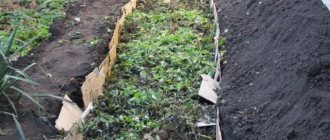Beets are a fairly unpretentious crop in terms of watering, but they still need to receive enough moisture. The size of root crops, their taste, and productivity depend on this. You can water beets in different ways. Common requirements are water requirements, frequency and intensity of irrigation.
How to properly water beets in open ground
How to water beets? This question interests many novice summer residents. First of all, take into account the time, frequency and abundance of irrigation .
Time, frequency and abundance of watering
Since beets are able to accumulate liquid, they do not need frequent watering. Severe waterlogging of the soil harms the root crop - it rots or becomes diseased.
Beets in open ground are watered once a week, preferably in the evening . This way the moisture will go into the soil, which will provide nutrition to the root crops. About 15-20 liters of water are used per square meter, depending on the weather. The hotter it is, the more water is lost.
Reference. Adult plants can go without watering for two weeks. But this is an extreme - do not forget about timely irrigation.
Why and should I water it?
From the moment the seeds germinate until they ripen, beets need regular watering. This crop prefers moderately moist soil; excess or lack of moisture leads to the development of diseases and reduced yields.
Water is involved in all vegetative processes and helps cells absorb minerals. If you ignore systematic watering, the taste of the root crop decreases and there is a risk of deformation and drying.
Irrigation methods
There are three ways to water beets: manual, drip and sprinkler.
Manual watering method
Manual watering is a simple method; it is moistened with a watering can or hose .
Watering can . When watering from a watering can, make sure that the irrigation is uniform. This also applies to water pressure. A strong jet damages seedlings and erodes the ground. To prevent this, special nozzles are used. The watering can is suitable for a small area.
Hose . When watering with a hose, special nozzles are also used that will prevent the soil from being washed away and damaging the sprouts. This method allows you to moisten a larger area.
Drip irrigation method
The drip irrigation method is used if it is necessary to cover a large area . Water is supplied to the roots of plants individually through special pipes or hoses with holes.
Important! Choose pipes that can withstand high water pressure. Otherwise they won't last long.
This method requires significant costs.
Sprinkling
Sprinkling is also used to irrigate beets. Drops that fall on the tops do not harm the plant .
In this case, the area is equipped with water sprinklers. The soil becomes evenly moistened and does not require loosening after watering. This method is also costly and is suitable for a large area.
Unpretentious but demanding beets
The non-capricious crop tolerates short droughts, but requires a certain frequency in the watering schedule. Most of all, beets need moisture during the spring growing season and in summer, when the process of formation and ripening of root crops is actively underway, but the debate about what to water beets in August does not subside.
Experienced summer residents agree that at this stage the plant needs not just moisture, but a nutrient solution of fertilizers. Minerals such as potassium and phosphorus are especially useful during this period; in addition, the plant needs a full complex of microcomponents: zinc, iron, magnesium, sulfur, etc., which will allow root crops to form a taste and aroma that meets the standard, accumulate a sufficient amount of useful substances and times to improve the commercial properties of the product. All substances are supplied in an easily digestible chelate form, and the best absorption is ensured by a solution in clean water.
In general, when it comes to irrigation, a general rule is followed: it is important to irrigate with a certain regularity, adding the volume of water in accordance with the stage of the growing season.
Features of watering
Depending on the growing season, beets need different frequency and volume of watering . Weather conditions also affect the amount of irrigation. If watering at one of these stages was incorrect, this affects the taste of the root crop.
It can be useful:
Growing table beets: from choosing a variety to harvesting
Instructions for planting beets in open ground in spring
How to properly plant beets in winter
Depending on the period
Landing .
Before planting the seeds, water the ground well. After planting, the beets are irrigated once a week. If the weather is hot, then the frequency of watering is increased. For 1 sq. m use 3-4 liters of water. At this stage, you should not irrigate the soil too much; water it as it dries. Flowering and appearance of the first shoots .
When the first shoots appear, the beets begin to be watered 2-3 times a week, depending on weather conditions. For 1 sq. m use about 10 liters of water. This continues until the sprouts reach a height of 15 cm and the first leaves appear on them. After this, the frequency of watering the plant is once a week. Fruit formation . Root crops are watered once every 7-10 days. The volume of water is increased to 15 liters per 1 square. m, hot days - up to 20 liters of water.
After feeding . At each stage of development, the plant needs feeding. These can be mineral and organic solutions containing nitrogen, potassium and phosphorus. For root feeding, the solution is poured directly under the root; for foliar feeding, the leaves are irrigated.
When the plant has 4-5 leaves , the beets are fertilized with boric acid - the leaves are sprayed with the solution. To do this, dissolve 4 g of boric acid in 10 liters of water. With a lack of boron, fomosis develops and the core of the root crop rots.
Depending on the month
In the second half of May, beet seeds are planted in the soil - the ground is watered before and after planting.
In June, beets are watered once a week. Use 10-15 liters of water per 1 sq. m.
Important! The first month of the growing season is especially important: if the plant does not receive enough moisture, it will stop in its development.
In July - the first half of August, the plant is watered 1-2 times a week. During this period, abundant watering is needed, since the root crop is already fed at a depth of more than 15 cm. Per 1 sq. m use two buckets of water.
In mid- or late August, watering is stopped to allow the fruits to form and become juicy.
Depending on weather conditions
Climatic conditions directly affect the frequency of watering beets:
- Heat. In hot weather, the frequency of watering is doubled. Irrigate the plant every 3-5 days. More water is consumed. If the norm is 15 liters, then in hot weather use 20 liters per 1 square meter. m. However, do not overfill.
- Rain. In conditions of heavy rainfall, beets do not need frequent watering.
- In cold weather, beets are watered only in the morning and lunchtime. The frequency of watering depends on the degree of drying of the soil.
Water requirements
The success of growing beets largely depends on the water used for irrigation. It must meet the following requirements:
- the temperature is similar to the ambient or soil temperature, too cold water is detrimental to the crop, optimal indicators are 12-23 degrees;
- water, regardless of its source, must settle, which ensures that harmful impurities settle and the water is heated to the required temperature;
- the water should not be too hard; to soften, you can add wood ash 3 g per liter, peat 100 g per liter or oxalic acid 1 g per every 5 liters.
Water of various origins can be used for irrigation:
- Rainwater is the best option for irrigation, provided that there are no harmful industries or other negative factors nearby. Drains and clean containers are used to collect rainwater.
- Tap water , if its temperature meets the requirements. If the source is a natural reservoir without treatment facilities, it is recommended to check the chemical composition of such water. It may be unsuitable for watering due to the content of pathogenic bacteria or fungi.
- Spring water , saturated with nutrients, can be effectively used if possible. It is very cold, so it needs to sit longer for natural heating.
- Salt water is used to water beets when they are low on sodium. This can be judged by the reddened leaves. Watering is carried out from a watering can with small holes. To prepare the solution, add a tablespoon of table salt to a 10-liter bucket of water. Be sure to wait for complete dissolution. Use regular salt without additives. It is effective to water beets with salt water when the root crops ripen. This fertilizing has a positive effect on the taste characteristics of the crop, increases sugar content and juiciness.
It is allowed to use the saline solution no more than 3 times during the entire period. If this product is abused, the soil will become salty, which is harmful for any plants.
How to learn to determine the moisture needs of beets
Each gardener himself determines whether the root crop needs irrigation or not.
The needs of the crop depend on the appearance of the plant and the soil itself - it should be moist, but not wet. Use your finger to check the depth of the moistened layer of soil in several places : if the soil is wet 5 cm deep, then there is no need for watering.
The second way is using a shovel . Stick it into the ground next to the root crop: if there is dirt stuck to the shovel, moisturizing is not required.
When to water?
The first application of water occurs at the time of sowing seeds in open ground or seedlings in containers. During the first stages of beet development, abundant and frequent watering is required.
Water must be stored in the upper layers of the soil, since the still short roots cannot extract it independently from the depths. That is why it is advisable to water in the morning or evening to avoid rapid drying under the influence of the sun.
It is especially important to add water during drought, and in rainy weather the need for the procedure is reduced.
Tips and recommendations from experienced summer residents
People with experience recommend following the following rules :
- There is no need to water the plants a little every day - the root crops do not receive enough moisture. The liquid evaporates quickly from the surface, and the beets do not absorb it.
- The first nutritional supplement is applied two days after sowing. Two glasses of wood ash are dissolved in a bucket of warm water. Leave for three hours and water the culture with this solution. Feeding will deliver nutrients directly to the root of the plant.
- Water is poured onto the bed itself. Make sure that it does not spread over the tops - this way, the water will get into the soil, and you will prevent the occurrence of fungal infections.
- To increase the concentration of sugar in the root crop, beets are watered with table salt and boric acid in June and August. During salt procedures (a level tablespoon of salt per 10 liters of water), the plants are also fed with fertilizers containing potassium.
- If the soil on the site is acidic, carry out one watering per season containing lime. At this point, the plant must have formed at least four leaves. For 12 liters of water use 250 g of lime. Fertilizer is applied strictly at the root, without dripping onto the tops.
Additional watering recommendations
To get a good beet harvest, it is not enough to adhere to the correct watering scheme for this crop. Other important recommendations must be followed. These include:
- at the initial stage, the bed should be formed in such a way that when watering, the liquid gets directly into the area of the root system of the crop, and does not spread over the surface;
- It is necessary to water the plant only with warm water, which has settled and reached the temperature of the soil;
- on very hot days, it is recommended to water the beets in the evening;
- in damp and cloudy weather, this procedure should be carried out in the morning so that the roots do not suffer from the cold at night;
- When watering beets from a hose, be sure to use spray nozzles so as not to damage the crop or erode the soil.
These tips are easy to follow. But they will help you get an excellent harvest that will delight the whole family.
Popular techniques
There are many ways to water beets, the most common are:
- Manual watering using a watering can or hose with a spray nozzle is the best option for small plantings. The nozzle allows you to split the water flow into several jets, which prevents erosion of the soil and exposure of part of the root crop, which negatively affects the health of the plant.
- The drip irrigation system is a highly efficient technological method for large plantations that eliminates human intervention. Water goes directly to the root system, bypassing the delicate above-ground parts, which prevents the formation of burns on the leaf. Thanks to this, drip irrigation can be carried out at any time of the day, without reference to the weather.
- The sprinkling method ensures high-quality saturation of the area to a sufficient depth and spraying of the tops. It is better to do it early in the morning so that the moisture has time to evaporate before the heat sets in, which will avoid burns on the sheet.
Beet feeding scheme
When growing beets, it is extremely important to apply fertilizers at certain stages, and at each of them they use fertilizers of different compositions. Beets are fed:
Beets are fed:
- at certain stages of the growing season;
- depending on the condition of the plants;
- during agricultural activities.
Fertilizers for beets are applied at the following stages:
- Preparing the soil for planting. The plot for beets is prepared in autumn and spring. Features of preparing a site for beets:
- Rotted manure is applied in the fall for digging - it should cover the area with a layer of 2 to 5 cm.
- Dolomite flour or crushed shells are added in the fall - 2-3 cups per 1 square meter. m.
- In spring, wood ash is added to the soil - 500 g per 1 square meter. m.
- Sandy soils and sandy loams are fertilized twice - in autumn and spring. For chernozems, fertilizing in the fall is sufficient.
- In heavy soils, an increased dose of potassium is introduced, as well as sawdust, sand and lime.
- When sowing. During this period, fertilizers are applied if they have not been added previously. Fertilizer is sprinkled directly into the furrows. For each square meter put 10 g of nitrate, superphosphate and potassium sulfate.
- During cultivation. Fertilizers are applied according to schedules that are based on calendar dates and growing seasons. Approximate feeding scheme:
- Fertilizers are applied for the first time after thinning the plantings. Take superphosphate, potassium sulfate and carbamide (urea) - 30 g each, dissolve in a bucket of water. This amount is enough for 10 sq. m.
- The second feeding is done after 3 weeks. Apply fertilizer of the same composition as the first time.
- The third is carried out after another 2-3 weeks. Its composition is already slightly different from the previous ones. Take double superphosphate and potassium sulfate - 40 g per bucket. The prepared solution is poured over 10 square meters. m. The beds are watered with this composition to enhance the growth of root crops.
- When growing late varieties of beets, another feeding is often carried out. It must be done 3-4 weeks before harvesting.
Automatic plant watering systems
An automated garden watering system will allow you not to waste extra time on this procedure, as well as evenly distribute moisture over a large area and save it. These systems come in the form of drip, jet and sprinkler systems - each has its own advantages and disadvantages.
So, sprinkling is not suitable for all crops - for example, cabbage, eggplants and tomatoes do not like it when it “rains on their heads”. In addition, irrigation is dangerous on a hot sunny day, because... is unable to quickly dissolve dried soil crust (especially on heavy clay soils) and only creates a lot of scorching lens droplets on the leaves. But lawn grass and young shoots will be grateful to you for this method of watering outside the active sun - large strong jets will not wash away their delicate roots. Automatic watering is also ideal for slopes and areas with complex microrelief.
An automatic sprinkler consists of a system of pipes dug into the ground and connected by ball valves. At their ends facing the surface, sprinklers of various types are attached (they are selected depending on the shape, size and topography of the area). The design is equipped with an electronic control that allows watering without your participation. You can set the start and end time of watering, jet pressure and other parameters.
Drip and jet irrigation systems can be either semi-automatic (they will have to be turned on and off manually) or automatic (the computer will do all the work). These are long hoses or tubes with holes pointing down and valves closed. Water comes here from a large storage tank and, opening the valves with its pressure, flows evenly and accurately to the roots of the plants, without being spent on evaporation and watering the surrounding weeds. The advantage of such a system is the possibility of its use in areas with uneven terrain and for the vast majority of crops. Possible problems are system clogging.
Choose a watering method that is suitable for your site and your plants, do not forget to “water” your garden on time and sufficiently - and a rich harvest will not keep you waiting.
Distinctive features of growing beets
In order to get a beet harvest and allow the sprouts to bear fruit, you need to know the basics and subtleties of caring for the plant. Caring for beets consists of sequential actions:
- sowing seeds;
- growing seedlings;
- picking planting material;
- transfer to open ground;
- watering, fertilizing and loosening the soil.
Beets are grown by direct sowing in open ground and growing seedlings. The second method is preferable, since seeds in open ground are exposed to climatic factors that negatively affect the expected yield.
Caring for beets begins with sowing seeds and growing seedlings. Before sowing the seeds, they need to be discarded. Select large seeds of the same size. One beet seed produces several sprouts, so you will need some seeds. After selecting the planting material, it is treated in a manganese solution. In this liquid, the seeds are treated against parasites. After the procedure, they are washed under running water and dried.
You can germinate seeds in soil. The structure of the soil is loose and fertile, and in it the beets produce a generous harvest. The technique of germinating seeds in damp cotton cloth is also popular. When the sprouts appear, the seedlings are picked and transplanted into the soil.
Sowing seeds for seedlings begins a month and a half before transplanting into open ground. Suitable time periods are April and June. While you are growing seedlings, prepare the land for transplanting seedlings there. The land must be dug up, cleared of weeds, treated for pests and fertilized.
Beets can be planted from seeds directly into the ground
Fertilizing the soil for planting beets is carried out as follows:
- Dig a ditch ten centimeters deep and about a meter wide.
- Place vegetation there: last year's grasses, cuttings of branches.
- Water the soil before laying it out.
- Pour hot water on top of the laid out vegetation and cover it all with film to create a greenhouse.
- Meanwhile, the seedlings are being prepared.
Seedlings are suitable when several leaves appear. The seedlings should get stronger and can be transferred to the prepared area. Seedlings are taken with a small amount of soil so as not to damage the root system and maintain the usual environment for the plant.
A feature of growing beets is the growth of seedlings and planting. It is easy to dive and tolerates it without problems, so this process should not be avoided.
She also quickly adapts to transplants. Therefore, the seedlings are first germinated, and then cultivation continues in open ground on your plot of land.
Beets easily tolerate diving
Is it possible to water currants with cold water?
Important! It is not recommended to water currants at the root with cold tap or well water, as this provokes the development of fungal diseases.
Interesting materials:
How is life expectancy calculated? How is sick leave calculated in 2019? How is salary calculated? How are maternity pay calculated in 2022? How to count two weeks of work upon dismissal? How to calculate continuous work experience according to a work book? How to calculate retirement age? How to calculate a 20 percent discount? How to calculate daily allowance when crossing the border? How to calculate retail space for UTII?
Watering vegetables in a greenhouse
Watering in a greenhouse has its own nuances. Yes, it should also be carried out during a period when the sun is not too active, yes, the frequency of watering also depends on the type of soil and the type of plant. However, we have already mentioned that greenhouse plants require more water than those in open ground, since due to the increased temperature the stems and leaves wither faster. Because of this same internal “climate,” more heated water can be used in the greenhouse for irrigation than outside on the site.
In addition, if there is excessive or improper watering, excess condensation may form inside the greenhouse - do not forget to ventilate the greenhouse after watering. Spot watering (bottle irrigation) will also help reduce the volume of condensate.
Watering cucumbers and tomatoes in a greenhouse, in principle, is not particularly different from that in open ground - monitor the soil moisture and the appearance of the plants.
The higher the temperature inside the greenhouse, the higher the air humidity around the tomatoes and cucumbers should be. To achieve this, you can place open containers of water near the beds, and also spray the plants and walls of the greenhouse with water. Don’t overdo it - by evening, make sure that there are no drops of water left on the bushes. For a standard greenhouse measuring 2x3 m, one 20-30-liter barrel is enough. As it evaporates, simply add water to the container.
Water cucumbers before flowering once every 5-7 days, and after - once every 2-3 days at the rate of about 10-20 liters per 1 sq.m. We remind you that cucumbers like to be watered at the root, and the water must be warm enough, otherwise it can provoke the appearance of fungal diseases.
Tomatoes in a greenhouse should not be watered in the first week after planting seedlings. Then water them every 3-7 days (more often in hot weather). Before flowering, this is done at the rate of 4-5 liters of water per bush, and after planting flower clusters - 1-2 liters. Increase the watering rate again to 3-5 liters already during fruit set.
Tomatoes should not be watered on the leaves, otherwise the plants will be poorly pollinated, the fruits will fall off, and there will be a high probability of infection with brown spot.
It is most convenient to water plants in a greenhouse or greenhouse using a watering can with a nozzle - this way the plants below and above on the racks will receive the right amount of moisture. If the area is large, automatic irrigation systems are needed. Of these, the drip type is considered the most economical for greenhouses, and the rain type is the most technologically complex. We will tell you what this is below.
If the greenhouse is too hot, hose down the paths with cold water. This will help lower the air temperature a little.
Signs of water shortage
When the tops of a vegetable begin to wither, this is a clear sign that there is not enough moisture in the soil.
To prevent this from happening, the shortage is determined by the condition of the soil:
- if it crumbles like powder, then this indicates drying out - urgent and abundant watering is required;
- the earth can be formed into a lump, but when it falls it crumbles - moderate watering is needed;
- the soil does not stick to your hands and when it falls, the formed lump does not scatter - it is enough to water only in hot weather;
- the rolled up ball of earth sticks to your hands - you don’t have to water it for a week;
- when you squeeze a clod of earth, drops of moisture appear on its surface - the earth is very wet and does not need to be watered for two weeks.
Preparing the beds
Beetroot today is grown in many garden plots and vegetable gardens in open ground. Despite the fairly simple care, there are special rules that must be followed if you want to get a high-quality and large harvest. A prerequisite for growing beets is feeding them. But for this you need to choose the right site and prepare the beds. Only in this case will the application of fertilizers achieve the desired result.
Beets must be grown in well-lit areas with light and well-drained soil. In such places, with timely application of fertilizers, you can achieve sweet tubers.
It is best to grow beets on sandy and loamy soils with neutral acidity. But on heavy and clayey soils it is unlikely that you will be able to grow sweet tubers, even with fertilizing. You should also avoid areas with stagnant moisture and high acidity of the soil.
It is worth noting that this crop grows well in open ground, when grown along the edges of the beds. This placement will allow you to save a lot on planting space and will make caring for the plantings much easier, since the beets will receive everything they need in terms of water and nutrition from their neighbors.
When you have chosen the right place to plant this crop, you need to form the beds according to all the rules. They begin to prepare them in the fall, after the entire harvest has been harvested and the plant mass has already been removed from the ground.
Preparing beds in the fall for spring planting of beets is as follows:
- the plot of land needs to be dug up well;
- digging is carried out to the depth of one shovel bayonet;
- After this, fertilizers should be added to the soil.
Some gardeners advise first scattering fertilizers over the area, and only then digging up the soil. During digging, it is necessary to break up the largest clods of earth.
In autumn, organic fertilizers are applied to the beds. It can be either compost or humus. Prepare fertilizer at the rate of half a bucket of fertilizer per square meter. In addition to organic matter, in the fall you can also apply mineral fertilizers, for example, ammonium nitrate or superphosphate (at the rate of 20-30 g/m²), as well as potassium chloride (10-15 g/m²).
If the soil has high acidity, then it is mandatory to add ash, lime or dolomite flour to the soil at this time.
Please note that when preparing beds for beetroot, you cannot add fresh manure to the ground. This will have a bad effect on the quality of the crop
Tubers, when fresh manure is added to the soil, will have an unattractive shape and will also accumulate a lot of nitrates.
Tubers, when fresh manure is added to the soil, will have an unattractive shape and will also accumulate a lot of nitrates.
In addition to preparing the beds in the autumn and applying fertilizers to the soil, fertilizing should be carried out before the actual planting of planting material in the spring. During this period, you need to fertilize the soil with wood ash. It is believed that this “folk” fertilizer will saturate the soil with a large amount of microelements. They will be needed for the active growth and development of plants. This is very useful both when growing crops in open ground and in a greenhouse.
Ash added to the soil will help neutralize its acidity. Therefore, after such fertilizing, the garden plot prepared in this way will become more optimal for growing this root crop. This will naturally lead to increased beet yields.
Intensity and frequency
As mentioned above, you need to water the crop only when it needs it. This is influenced by factors such as growth phase and environmental weather conditions. Beets are a vegetable that has the ability to store moisture. During dry periods, she uses it sparingly. Therefore, waterlogging can cause more harm to it than drought.
An adult plant can be left without water for at least 2 weeks. You can’t do this with young shoots that need careful care. If moisture has nowhere to go, it can lead to negative consequences. Root vegetables rot and crack over time.
Why is it important to follow the watering regime?
Why do you need to reduce the amount of water when root crops ripen?
First of all, the fact is that excess liquid in root vegetables will not allow them to ripen in the correct way, which will negatively affect their storage in the winter.
Frequent watering
In addition, frequent watering will lead to:
- This can cause the plant to rot, especially if the soil is too wet and the weather is cold.
- The carrot begins to produce small white roots from its “eyes,” which negatively affects its taste and micronutrient content.
- Crops containing excess water begin to crack during storage.
Lack of moisture
But lack of moisture can also negatively affect the formation of yield in these two crops:
- Roots will be small, tough and misshapen;
- The plant may throw out the peduncle;
- The fruits will be unripe and will begin to dry out even if stored correctly.
A correctly chosen irrigation regime will allow you to obtain a high-quality harvest and preserve it for a long time.
Answers to pressing questions from gardeners
Water should get under the plant and not spread over the bed.
Question No. 1. How should you water beets on clay soils?
Clay soils are dangerous for plants due to stagnant water. It accumulates in the top layer due to poor water permeability, creating waterlogging during watering; the roots rot and remain without access to oxygen. This condition creates erosion, crusting and cracking of the earth. Improving the soil structure helps: adding peat, compost, sand, loosening. Watering should be done in small volumes, judiciously adjusting the frequency.
Question No. 2. If the soil is sandy, what are the guidelines for watering root crops?
Sand quickly allows water to pass down and dries very quickly. Therefore, the roots experience an increased need for moisture. Watering is required frequently. These types of soils require improving the structure and adding humus, peat, and compost.
See the table below for the area of sandy soil moistened during irrigation.
| Type of sand in the soil | Area of soil moisture, radius in m. |
| Coarse fraction | 0.13 – 0.47 |
| Small fraction | 0.4 – 0.93 |
Question No. 3. How to care for irrigation water storage containers?
Water tanks are usually made from iron sheets by welding and installed at some elevation above the ground. To prevent the metal from rusting, it must be painted black to allow the water to warm up well in the sun; it can be coated with bitumen or bitumen mastic. At the end of the season, the water must be drained so that the container does not burst with frozen ice.
Question No. 4. What types of pipes are used for irrigation water supply on the site?
The following types of pipes are usually used: simple and galvanized metal, plastic, asbestos-cement, cast iron.
Question No. 5. What is "soft water"?
For “soft” water supply, reinforced or ordinary rubber hoses are used, which are often buried in the ground to a depth of 30 cm, so they are less damaged by the sun. For the winter, it is recommended to disassemble the system and store the hoses rolled up indoors.
When moisture is required: learning to determine
If you are in doubt about how often to water beets in open ground, and you think that once or twice a week will not be enough, then try to learn how to independently determine whether the plant requires moisture or not. To do this, simply stick your finger into the soil of the bed in different places. If the layer on top (2-3 cm) is dry, but further down it is wet, then there is no need to add water.
A mechanical check, without getting your hands dirty, is possible if you stick a shovel, deepening it with a bayonet, within the boundaries of the bed itself. After that, pull it out. Is there dirt stuck to it? This means there is enough moisture. When the soil only slightly sticks to the shovel, but is well compressed in the hand, you can also wait to add water for at least another day. Only when the soil is crumbly and dry is watering required.
Beets, of course, do not like excess moisture, because this reduces the amount of oxygen in the soil, the roots of root crops rot, the acidity increases and the soil simply erodes. An abundance of dampness equates to creating a perfect environment for the spread of disease. But too little watering will also not do anything good for the beets. By the way, most summer residents make both of these mistakes - they water
garden
either daily or very sparingly. If there is a lack of moisture, only the weeds receive the liquid, while the beets remain without it. Do you think you will get a good harvest in this case? Of course not.
You can find out that beets require more frequent watering by simply inspecting the tops. With a lack of moisture, it acquires burgundy shades and becomes small.
Preparation of the solution
The main ingredient for preparing such a solution is ordinary table salt. The concentration of the component is determined by the state of the tops. If the sodium deficiency is slight, 10 liters of water with a teaspoon of salt dissolved are used to water a square meter of soil. If the leaves are covered with a large number of red veins, this indicates a severe lack of sodium. In this case, in 10 liters of water you need to dissolve not 1 teaspoon of the component, but 2. If the main task of the gardener is to protect the plants from insect attacks, use a solution in which 5 grams of salt is taken per liter of water. Increasing the dosage of sodium chloride is strictly prohibited, since treatment with a concentrated composition can cause the death of the plant. You need to prepare the fertilizer very carefully, making sure that there are no undissolved crystals in the liquid.
When preparing fertilizing, it is recommended to adhere to the following algorithm:
- To begin, take the required amount of salt and add 5-7 tablespoons of water.
- Next, you need to heat the composition, which will help dissolve the salt crystals.
- Now you need to pour the prepared concentrate into the water, mix everything well and let it brew for 10 minutes.
Further watering is carried out in the standard way, using a watering can or from a bucket. If the solution is used to protect against pests, it is recommended to spray using a spray bottle.
For the best effect, it is recommended to pour sodium chloride solution into the grooves, which are made at a distance of 8-10 cm from the root system. This method will help prevent burns and injury to the roots.
It is important to remember that the plant must first be watered with plain water.
Advantages and disadvantages of watering with salt
The first thing that needs to be noted is the fact that salt fertilizing will be in no way inferior to expensive mineral fertilizers. The natural remedy will not harm either the vegetable crop or humans after consuming root vegetables. It is considered environmentally friendly and safe.
The advantages of watering with salted water are as follows:
- the soil is saturated with missing microelements;
- beet tops are protected from yellowing and drying out;
- good prevention against eating root crops by rodents;
- imparting sugar content to beets and improving taste;
- reducing the risk of developing diseases.
The product is very popular due to its low cost and the possibility of making it yourself.
In addition to the advantages, watering with salt-containing liquid also has disadvantages. If you do not follow the dosage and exceed the number of waterings, you can only harm the crop. Therefore, experienced gardeners warn that such fertilizing should be applied moderately and with some regularity.
Basic rules for watering beets with saline solution
It is important to water with salt water correctly, observing the proportions and regime. In order not to harm the culture, the solution is prepared, carefully adhering to the recipe.
Preparation of saline solution
How to make salt fertilizing so as not to harm the future harvest? To achieve the correct concentration, you must adhere to the specified proportions. Each gardener decides independently on the chosen method, based on the goals he wants to achieve.
So, the solution is prepared as follows:
- Heat the water to room temperature (24-26°C);
- add salt and mix well until it is completely dissolved;
- leave to cool slightly for 10-12 minutes;
- Stir again before starting watering.











